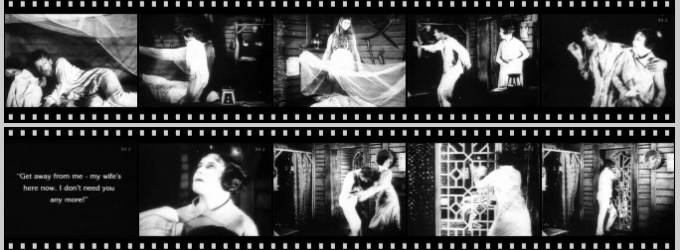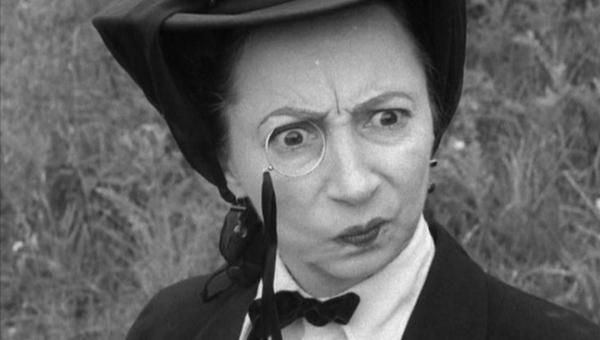
For one brief moment Stephen Horne’s live accompaniment to the early Alfred Hitchcock feature THE PLEASURE GARDEN swirls around similar chords to Bernard Herrmann’s score in VERTIGO. The chorus girl heroine meets a moustachioed cad on a dark street at a time of vulnerability, with more than a nod to the themes of mixed identities to come in later work. Horne’s melancholy riff and the film print’s blue tint complete the homage.
It creates a curious resonance, as most of the audience will have seen Hitchcock’s later work before watching this one. Hitchcock’s 1958 masterpiece provides a Möbius strip of infinite feedback for those watching this 1925 outing. Where one film ends and the other begins becomes fuzzy. With one brief sequence Horne earns his keep and makes us all reflect on how we arrive at a director’s back catalogue.
… one of the lechers drools at one girl’s ankle only for her to wither in distaste …
Music aside, though, THE PLEASURE GARDEN provides plenty of visual cues to what was to come. Set in a London music hall, from which the film takes its name, proceedings open with a line of fat old businessmen gawping at the girls dancing on stage. Famously (for film critics at least) one of the lechers drools at one girl’s ankle only for her to wither in distaste under his scrutiny: a scene dying to be compared to Hitchcock’s love of voyeurism.
He also throws in a sight gag at this point, with one of the duffers looking without his opera glasses and the audience sharing his wildly unfocused view. All at once it links cinema’s early playfulness associated with the Méliès brothers and, almost, suggests that mind-trepanning dolly zoom from VERTIGO. Of course, returning to the music, one might blame Stephen Horne’s soundtrack for this line of thought.
… mismatched lovers, girls who look a bit similar, canny canines, dodgy flats in Brixton …
On from here the film has mismatched lovers, girls who look a bit similar, canny canines, dodgy flats in Brixton and the unusual approach of having the hero rescue his girl by proxy. One of the love-interests heads off to the colonies to make his fortune. Yet when the heroine eventually makes it out there too, the malarial slouch only bothers to show up after the climax, in a hammock slung between his porters. His manservant Carruthers actually takes the trouble to finish off the villain.
Final mention should be made of the coloured tints the BFI have added to this new version. Flipping between yellow and blue, often between outside and inside, the tones add emotional depth to various scenes. For example, the music hall scenes burn up the screen with colour, creating something like the glare of the spotlight. Playfully, the restoration team take their lead from Hitchcock. At one point the tint jumps from blue to yellow as the characters flick on the light switch in their flat. Sublime.
httpvh://youtu.be/6kSxX3t9lys

